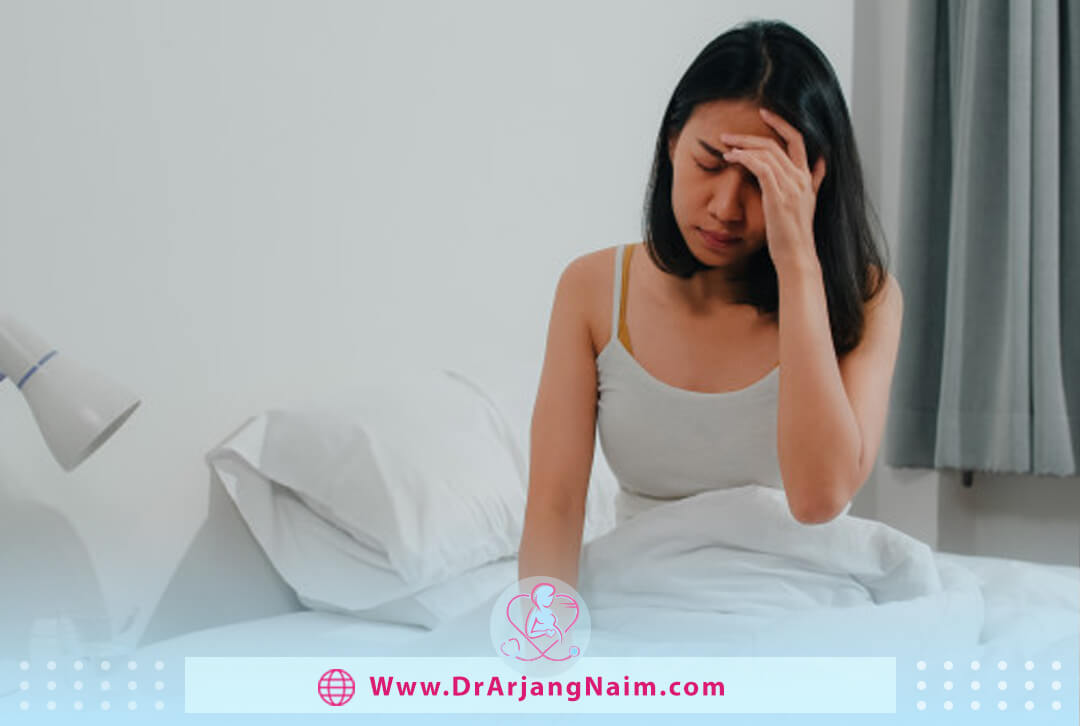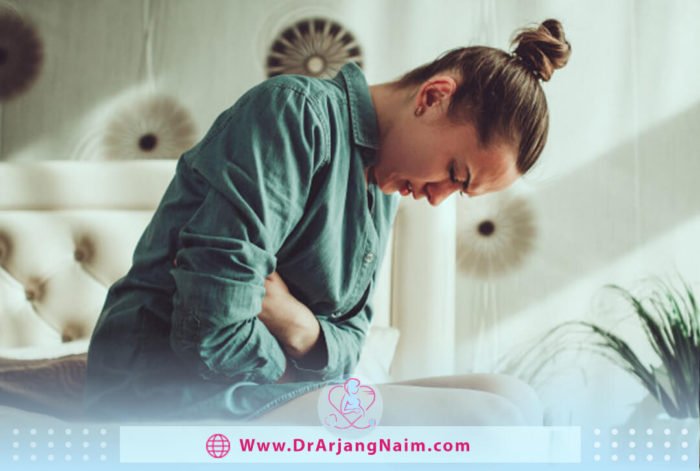Premenstrual Syndrome, or PMS, is a physical and psychological symptom that women experience in the week or two leading to their period. Headache, bloating, muscle cramps, and mood swings are the most common symptoms of it. These symptoms are minor discomfort; for some people, they can be so severe that they interfere with their daily activities.
It is estimated that three out of every four women of childbearing age and menstruation experience the syndrome. Symptoms occur in a predictable pattern, but the physical and emotional changes a person experiences in PMS may be mild or even severe.
What is premenstrual syndrome?
Premenstrual syndrome refers to various physical and psychological symptoms that people experience before their period. The exact cause of Premenstrual syndrome is unknown. However, natural hormone changes, especially estrogen and progesterone, may be responsible for these symptoms in the first week or two before menstruation.
Estrogen and progesterone levels drop dramatically after ovulation, which can play an essential role in developing PMS symptoms. Decreased estrogen levels may also affect a person’s serotonin levels. Serotonin is a brain chemical that helps regulate mood, sleep, and appetite, all of which affect PMS.
What is PMDD?
Premenstrual dysphoric disorder (PMDD) is a health problem similar to Premenstrual syndrome but is more serious. PMDD can cause severe irritability, depression, or anxiety a week or two before menstruation. Symptoms usually go away two to three days after the start of the period. Experiencing PMDD can make it difficult to work, socialize and have healthy relationships. PMDD and PMS may cause bloating, breast tenderness, fatigue, and changes in sleep and eating habits. However, at least one of these emotional and behavioral symptoms is prominent in PMDD, such as:
- Sadness or hopelessness
- Anxiety or tension
- Extreme moodiness
- Marked irritability or anger
Premenstrual syndrome symptoms

Menstruation happens almost every 30 days and generally starts when women are in their teens. Menstruation occurs in almost every woman, except for a few specific cases, but unfortunately, it has unwanted side effects. The severity of side effects will vary from woman to woman; some are so lucky that they can hardly feel it.
Insomnia
Adequate and quality sleep is very important in all stages of life. Insufficient sleep causes a person to become very tired during the day, making it difficult to continue working and other responsibilities. Prolonged periods of insomnia can also have a significant impact on physical and mental health. Some women who experience premenstrual symptoms find it difficult to sleep at night. In this case, getting help from some foods can help people who want to take medicine to be sure to consult a doctor.
Mood swings
Naturally, each person’s mood changes from time to time. External events can change hormone levels, leading to changes in emotions. This is essential because it helps us react to the events around us. Sometimes, our moods can change for entirely different reasons. One of the most common premenstrual symptoms is a sudden change in mood. This happens because hormone levels change, and they try to adapt to a new phase of life.
Libido changes
Sexual desire motivates us to have sex. Different people have different levels of sexual desire; some people always want to have sex, and others do not. Some women who experience premenstrual symptoms experience a change in sexual desire. Some women do not want sex before their period, while others want sex.
Headaches
Headaches can be unexplained and sometimes difficult to treat. In these cases, some painkillers can help. Women who are approaching menstruation often know that headaches will start again soon. The severity of the headache ranges from mild to severe. If you experience severe headaches, be sure to talk to your doctor.
Fatigue
Changes in hormone production around the menstrual cycle can lead to extreme tiredness and lethargy. Estrogen acts as a sedative on the body and slows down activity. This natural defense mechanism prevents women from engaging in strenuous activity during the days around menstruation. This symptom affects every woman; some have difficulty seeing the signs of fatigue, while others may even feel tired when they wake up in the morning. Drinking coffee and exercising are the best ways to reduce fatigue.
Anxiety, tension, and crying
Elevated progesterone and estrogen during the menstrual cycle can cause different feelings in a person. Many women find that they feel frustrated by increasing levels of these hormones. When this level peaks, some women become emotionally disturbed and prone to crying.
With the onset of premenstrual hormone changes, feelings of stress and anxiety may develop. Our hormones control every biological and nervous process in our body. Disorders in their normal functioning lead to a variety of psychological conditions. Anxiety occurs due to an increase in the hormone cortisol. Increased estrogen is also a cause of depression. However, most of these symptoms go away after the menstrual cycle ends. If you are still feeling depressed, anxious, and nervous after your period, you need to see a psychiatrist.
Poor concentration
It is important to focus on our work to get things done when we are at work. The same is true when doing household chores and even in social settings. However, some days it becomes difficult to stay focused. Women who suffer from the symptoms of Premenstrual syndrome often find that they have difficulty concentrating. This can make it difficult for them to do the job effectively.
Food cravings
Dietary changes can also be a symptom of this period. Depending on the particular health condition, some people may feel hungrier than usual. Women who have PMS symptoms sometimes find that they crave foods that they do not normally eat and generally overeat.
Bloating
Overeating or drinking too much fluid will cause bloating. This is quite understandable because it takes time for our bodies to process food. Women who experience premenstrual syndrome symptoms often experience bloating, but this is not just about the amount of food they eat. Women approaching menstruation may retain water in the abdomen. This is due to fluctuations in hormone levels. With the onset of menstruation, bloating completely subsides.
Hot flushes
Hot flashes are a symptom that women may experience. Most women feel warm, which has nothing to do with the outside temperature. Hot flashes occur due to hormonal changes in premenstrual syndrome.
Gastrointestinal issues
Gastrointestinal problems are a general term that refers to the entire digestive system, meaning sudden issues with the stomach or intestines that a person has not experienced before and felt before menstruation. All of them can be attributed to hormones and changes in the body. In most cases, the gastrointestinal upset that most women experience is bloating.
Weight changes
Premenstrual syndrome not only affects appetite and gastrointestinal health but may also affect metabolism and weight. It is a symptom experienced by different people; some people experience sudden weight gain, while others experience sudden weight loss.
Acne
Sometimes, PMS symptoms can show the same signs as during puberty; however, they are the same hormones that cause these changes in the body. One of these symptoms is acne. Even if a woman has never had acne during adolescence, it may occur suddenly during this period.
Cause of premenstrual syndrome
The exact cause of PMS is unknown, but several factors can exacerbate it:
- Periodic changes in hormones: The signs and symptoms of premenstrual syndrome change with hormonal changes and disappear with pregnancy and menopause.
- Chemical changes in the brain: Fluctuations in serotonin, a brain chemical that appears to play an important role in mood swings, can cause symptoms of PMS. Insufficient serotonin may cause premenstrual depression, fatigue, increased appetite, and sleep problems.
- Depression: Some women with severe Premenstrual syndrome have undiagnosed depression, although depression alone does not cause all the symptoms.
How is premenstrual syndrome diagnosed?
So far, there is no definitive way to diagnose premenstrual syndrome and no test. If women experience specific symptoms each month during their menstrual cycle, their doctor will evaluate them and conclude that they may have PMS. The doctor will ask the person to record their signs and symptoms for two menstrual cycles accurately; this will help diagnose the syndrome more accurately.
How many women suffer from premenstrual syndrome?
About 90% of women experience premenstrual symptoms at some point. The true incidence of premenstrual syndrome is often estimated by considering all women who experience premenstrual physical or emotional symptoms. It is estimated that clinically significant PMS, moderate to severe in severity and affects female performance, occurs in 20% to 30% of women.
What conditions mimic PMS?
Some examples of medical conditions that can mimic include:
- Chronic fatigue
- Depression
- Cyclic water retention
- Hypothyroidism
- Irritable bowel syndrome
PMS diagnosis’s main feature is this asymptomatic interval after the menstrual cycle and before the next ovulation. If there is no such interval and symptoms persist throughout the process, it may not be a good diagnosis. PMS can still present and exacerbate other conditions’ associated symptoms, but it cannot be the only cause of persistent or non-cyclical symptoms. Blood tests or other tests may be given to rule out other possible causes of the symptoms.
Treatments

The treatment options vary depending on the individual’s specific symptoms. People can manage PMS symptoms by taking medication, changing their diet, exercising, and making other changes.
Medication
Medications can help reduce symptoms. These medications include:
- Analgesics, such as acetaminophen, can help relieve muscle pain, muscle cramps, and headaches.
- Nonsteroidal anti-inflammatory drugs (NSAIDs) can reduce cramps, headaches, and muscle aches.
- Diuretics, which can help relieve bloating and breast pain
The doctor may recommend that women take birth control pills to reduce their symptoms for severe PMS symptoms. These drugs affect the amount of estrogen and progesterone in the body.
Use relaxation techniques
Gentle exercises such as walking and stretching can help reduce the symptoms of PMS. Stress management and relaxation techniques, such as deep breathing or meditation, can help regulate the emotional imbalance. Other examples of stress management and relaxation techniques include:
- Yoga
- Stretching
- Taking a bath
- Going for a walk
- Exercise
Gentle exercise can increase estrogen and progesterone levels, which may help reduce the symptoms of PMS.
Relieve bloating
Bloating can cause a heavy feeling. People can reduce PMS related bloating by:
- Do not eat salty foods
- Eat foods rich in potassium
- Stay hydrated
- Do gentle exercise
Eat certain nutrients
Making some dietary changes may reduce the symptoms of mild to moderate PMS.
Reduce salt
Avoid fast food or processed foods. Eating less salt is especially recommended for patients with bloating, breast tenderness, or swelling of the hands.
Eat a variety of fruits and vegetables
Eating colorful fruits and vegetables can help reduce the symptoms of Premenstrual syndrome.
Drink plenty of water
Women should drink at least 64 ounces of water daily to reduce bloating and aid digestion. If you do not like the taste of water, flavor it with lemon.
Eat more calcium
Calcium supplements are an effective way to reduce mood disorders during PMS. Eating more calcium in foods such as yogurt, milk, soy products, and low-fat cheese can also reduce the symptoms.
Get vitamin D
In addition to supplements, vitamin D is found naturally in foods such as sardines, oysters, and salmon. Increasing vitamin D can help reduce the symptoms of PMS.
Snack on nuts
Instead of looking for a bag of chips or that candy, eat raw, unsalted nuts. Nuts are rich in omega-3 fatty acids and help you feel full longer.
Eat complex carbohydrates
Foods that contain complex carbohydrates are made up of three or more natural sugars and are high in fiber. These nutrients gradually enter the bloodstream and only increase the average insulin level, helping stabilize the mood and control food cravings.
Limit alcohol
Alcohol can interfere with sleep, thus exacerbating the effects of Premenstrual syndrome.
Limit caffeine
Too much caffeine can also interfere with sleep and play a role in the symptoms of PMS. Try to eat the last cup of coffee about four to six hours before bedtime and limit its amount.
Eat iron-rich foods
To replace the blood women lose during menstruation, they must increase their iron levels before and during menstruation. An iron-rich diet, such as lean cuts of meat, may help prevent anemia.
Don’t smoke
In one study, women smokers experienced more severe PMS symptoms than women who did not smoke.
Get a full eight hours of sleep
One of the symptoms of Premenstrual syndrome is fatigue, so women should try to increase their relaxation during these weeks. This includes trying to get more sleep by going to bed earlier. Avoid caffeinated beverages before bed or eat late meals to ensure a full eight hours of sleep.
What supplements help with PMS?
Many companies produce products that claim to improve or reduce the symptoms of PMS. It is essential to talk to your doctor before taking any supplements.
Calcium
A study of women who took 500 mg of calcium carbonate twice daily for three months found that they were less tired, less prone to appetite, and less depressed than women with PMS who did not take supplements. Get 1200 mg of calcium a day through food or supplements.
Magnesium
Taking about 360 mg of magnesium daily may help reduce the symptoms for women with bloating, fluid retention, and tenderness in the breast.
Essential fatty acids
Essential fatty acids, or EFAs, are essential for many reasons; they can help prevent depression, heart disease, and organ abnormalities and may also help treat PMS.
Evening primrose oil
Evening primrose oil is another herbal supplement that may help with PMS.
Vitamin B-6
Vitamin B-6 produces neurotransmitters, which play a major role in mood. It is a water-soluble vitamin found in many foods we eat. A daily vitamin B-6 supplement can help with many psychological symptoms, including lethargy, irritability, and anxiety.
The bottom line
Most women experience at least one symptom of PMS. Fluctuations in hormone levels may play a role in PMS, but the exact cause is still unknown. A small percentage of people can develop a severe form of this syndrome called PMDD. Taking painkillers, making proper dietary changes, and controlling stress can all help reduce symptoms. Be sure to see a gynecologist if symptoms do not improve or worsen despite treatment or interfere with your ability to perform daily tasks.
Arjang Naim, MD examines the symptoms by taking a complete history and offers the best solution to reduce premenstrual syndrome symptoms.
Additional questions
- What are the simple solutions for premenstrual bloating remedies?
- Pick protein- and potassium-rich foods.
- Stay away from foods that cause gas.
- Don’t skip your workout routine.
- Cut back on caffeine and alcohol (just for now).
- Pop an OTC anti-inflammatory.
- Ask your ob-gyn about going on the pill.
- Cook at home more often.
- What is the best vitamin for PMS?
- Calcium
- Vitamin D
- Vitamin B-6
- Vitamin B-12
- Magnesium
- Fatty Acids
- Zinc
- What are the three types of IBS?
- IBS with constipation (IBS-C)
- IBS with diarrhea (IBS-D)
- IBS with mixed bowel habits (IBS-M)
- What are the four complex carbohydrates?
- Whole grains such as brown rice, wild rice, oatmeal, and whole-grain barley
- Grain-like foods such as quinoa and buckwheat
- Starchy vegetables, including potatoes, sweet potatoes, and corn
- Non-starchy vegetables
- Beans and legumes
- What discharge comes before the period?
The white discharge you may see before your period is known as leucorrhea. It is full of fluid and cells that come out of the vagina and may even look a little yellow sometimes. This part of the menstrual cycle is called the luteal phase. It is the time when the progesterone hormone in the body reaches its peak.
References
https://www.womenshealth.gov/menstrual-cycle/premenstrual-syndrome
https://www.webmd.com/women/pms/what-is-pms
https://www.medicinenet.com/premenstrual_syndrome/article.htm
https://www.webmd.com/women/pms/supplements-help-with-pms
https://www.healthline.com/health/pms-supplements#st.-john’s-wort
https://www.healthline.com/health/premenstrual-syndrome#outlook




